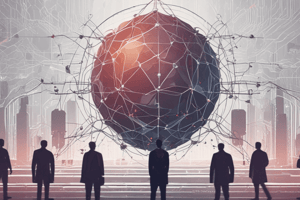Podcast
Questions and Answers
What is a common cybersecurity threat that exploits human behavior to gain unauthorized access?
What is a common cybersecurity threat that exploits human behavior to gain unauthorized access?
- Phishing attacks
- Social engineering attacks (correct)
- DDoS attacks
- Insider threats
What is the estimated global cost of cybercrime by 2025?
What is the estimated global cost of cybercrime by 2025?
- $10 trillion
- $6 trillion
- $8 trillion
- $12 trillion (correct)
Which of the following is NOT a recommended cybersecurity defense measure for organizations?
Which of the following is NOT a recommended cybersecurity defense measure for organizations?
- Encrypting key data
- Conducting risk assessments and security audits
- Implementing anti-virus software
- Allowing unauthorized access to critical systems (correct)
Which of the following is a unique challenge for IoT security?
Which of the following is a unique challenge for IoT security?
What is the primary goal of a Distributed Denial of Service (DDoS) attack?
What is the primary goal of a Distributed Denial of Service (DDoS) attack?
Which of the following is a recommended individual cybersecurity defense measure?
Which of the following is a recommended individual cybersecurity defense measure?
Which of the following statements accurately describes the relationship between cybersecurity and information security?
Which of the following statements accurately describes the relationship between cybersecurity and information security?
Which of the following is NOT a type of cybersecurity mentioned in the text?
Which of the following is NOT a type of cybersecurity mentioned in the text?
Which of the following best describes the purpose of network security?
Which of the following best describes the purpose of network security?
Which of the following techniques is NOT mentioned in the text as being used for cybersecurity?
Which of the following techniques is NOT mentioned in the text as being used for cybersecurity?
What is the primary focus of endpoint security according to the text?
What is the primary focus of endpoint security according to the text?
What is the primary goal of application security?
What is the primary goal of application security?
Flashcards are hidden until you start studying
Study Notes
Cybersecurity: A Critical Aspect of Information Technology
Understanding Cybersecurity
Cybersecurity is a critical aspect of information technology that involves the protection of computer systems, networks, programs, devices, and data from cyber attacks through both technological means and management processes. Information security, on the other hand, focuses specifically on protecting the confidentiality, integrity, and availability of an organization's data. Both cybersecurity and information security involve implementing multiple layers of protection, including staff awareness training, identity and access management, threat detection, disaster recovery planning, and business continuity strategies.
Types of Cybersecurity
Cybersecurity can be categorized into several types based on their focus areas:
Network Security
Network security involves various methods used to protect networks from breaches and intrusions, typically achieved through access control, network analytics, firewalls, VPN encryption, and other techniques.
Endpoint Security
Endpoint security is focused on securing devices connected to a network, such as desktops, laptops, mobile devices, and IoT devices, which often have no inherent security features of their own.
Application Security
Application security aims to ensure software applications are secure by fixing vulnerabilities, conducting continuous security testing, using authentication measures, and employing firewalls.
Internet of Things (IoT) Security
IoT security raises unique challenges given the vast amount of data collected by connected IoT hardware, which must include smart home devices, industrial sensors, and other IoT devices lacking native security features.
Potential Cybersecurity Threats
New cyber threats emerge constantly, but some common risks include:
- Phishing attacks that use psychological tactics to persuade individuals to divulge sensitive information.
- Social engineering attacks that exploit human behavior to gain unauthorized access.
- Insider threats where authorized personnel intentionally or unintentionally compromise security.
- Distributed Denial of Service (DDoS) attacks, which aim to overwhelm servers and prevent legitimate users from accessing resources.
As cybercrime continues to grow rapidly, reaching an estimated $12 trillion globally by 2025, organizations face increasing pressure to prioritize cybersecurity defenses. Companies must adapt their cybersecurity programs to keep pace with evolving digital technologies, software vulnerabilities, and advanced attack vectors. Implementing tips like anti-virus software, strong passwords, regular updates, and multi-factor authentication provides a foundation for individual defense. Organizations should also conduct risk assessments, security audits, train staff, encrypt key data, limit access, enforce password policies, and maintain cyber insurance.
In conclusion, cybersecurity plays a crucial role in safeguarding our increasingly digital world. By understanding different aspects of cybersecurity and staying updated on emerging threats and best practices, organizations can better defend against potential attacks.
Studying That Suits You
Use AI to generate personalized quizzes and flashcards to suit your learning preferences.




